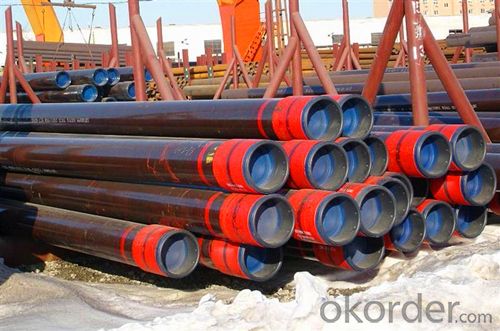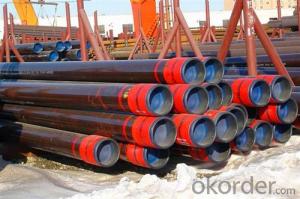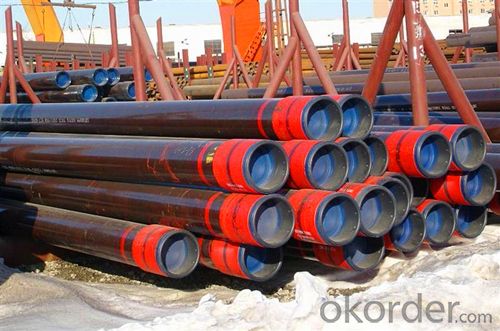Casing Pipe of Grade L80 with API Standard
- Loading Port:
- Qingdao
- Payment Terms:
- TT OR LC
- Min Order Qty:
- 20 m.t.
- Supply Capability:
- 2000 m.t./month
OKorder Service Pledge
OKorder Financial Service
You Might Also Like
1. Structure of Casing Pipe of Grade L80 Description
API 5CT Steel Pipe, L80 Oil/Petroleum Casing Pipe, OCTG
1) Grade: J55,K55,L80,N80Q,C90,T95,P110
2) Size: 4 1/2", 5", 5 1/2", 6 5/8", 7", 7 5/8", 9 5/8", 10 3/4", 13 3/8", 16", 18 5/8", 20"
3) Wall thickness: 6.35 - 12.70 mm
4) Thread type: STC, LTC, BTC
5) Length: R1,R2,R3
6) All our casings accord with API 5CT standard.
2. Main Features of Casing Pipe of Grade L80
1) Advanced test for quality
2) MTC, COC provided
3) Supervision is welcome
3. Casing Pipe of Grade L80 Images



4. Casing Pipe of Grade L80 Specification
Size Destination | Weight Destination | Outside Diameter | Wall Thickness | Type of End Finish | ||||||
Grade | ||||||||||
in | mm | in | mm | J55 | L80 | N80 | C90 | P110 | ||
4 1/2 | 9.50 | 4.500 | 114.3 | 0.205 | 5.21 | PS | - | - | - | - |
10.50 | 0.224 | 5.69 | PSB | - | - | - | - | |||
11.60 | 0.250 | 6.35 | PSLB | PLB | PLB | PLB | PLB | |||
13.50 | 0.290 | 7.37 | - | PLB | PLB | PLB | PLB | |||
15.10 | 0.337 | 9.56 | - | - | - | - | PLB | |||
5 | 11.50 | 5.00 | 127.00 | 0.220 | 5.59 | PS | - | - | - | - |
13.00 | 0.253 | 6.43 | PSLB | - | - | - | - | |||
15.00 | 0.296 | 7.52 | PSLB | PLB | PLB | PLBE | PLB | |||
18.00 | 0.362 | 9.19 | - | PLB | PLB | PLBE | PLB | |||
21.40 | 0.437 | 11.10 | - | PLB | PLB | PLB | PLB | |||
23.20 | 0.478 | 12.14 | - | PLB | ||||||
24.10 | 0.500 | 12.70 | - | PLB | ||||||
5 1/2 | 14.00 | 5.500 | 139.7 | 0.244 | 6.20 | PS | - | - | - | - |
15.50 | 0.275 | 6.98 | PSLB | - | - | - | - | |||
17.00 | 0.304 | 7.72 | PSLB | PLB | PLB | PLBE | PLB | |||
20.00 | 0.361 | 9.17 | - | PLB | PLB | PLBE | PLB | |||
23.00 | 0.415 | 10.54 | - | PLB | PLB | PLBE | PLB | |||
6 5/8 | 20.00 | 6.625 | 168.28 | 0.288 | 7.32 | PSLB | - | - | - | - |
24.00 | 0.352 | 8.94 | PSLB | PLB | PLB | PLBE | PLB | |||
28.00 | 0.417 | 10.59 | - | PLB | PLB | PLBE | PLB | |||
32.00 | 0.475 | 12.06 | - | PLB | PLB | PLBE | PLB | |||
7 | 17.00 | 7.00 | 177.80 | 0.231 | 5.87 | - | - | - | - | - |
20.00 | 0.272 | 6.91 | PS | - | - | - | - | |||
23.00 | 0.317 | 8.05 | PSLB | PLB | PLB | PLBE | - | |||
26.00 | 0.362 | 9.19 | PSLB | PLB | PLB | PLBE | PLB | |||
29.00 | 0.408 | 10.36 | - | PLB | PLB | PLBE | PLB | |||
32.00 | 0.453 | 11.51 | - | PLB | PLB | PLBE | PLB | |||
35.00 | 0.498 | 12.65 | - | PLB | PLB | PLBE | PLB | |||
38.00 | 0.540 | 13.72 | - | PLB | PLB | PLBE | PLB | |||
7 5/8 | 24.00 | 7.625 | 193.68 | 0.300 | 7.62 | - | - | - | - | - |
26.40 | 0.328 | 8.33 | PSLB | PLB | PLB | PLBE | PLB | |||
29.70 | 0.375 | 9.52 | - | PLB | PLB | PLBE | PLB | |||
33.70 | 0.430 | 10.92 | - | PLB | PLB | PLBE | PLB | |||
39.00 | 0.500 | 12.70 | - | PLB | PLB | PLBE | PLB | |||
42.80 | 0.562 | 14.27 | - | PLB | PLB | PLB | PLB | |||
45.30 | 0.595 | 15.11 | - | PLB | PLB | PLB | PLB | |||
47.10 | 0.625 | 15.88 | - | PLB | PLB | PLB | PLB | |||
8 5/8 | 24.00 | 8.625 | 219.08 | 0.264 | 6.71 | PS | - | - | - | - |
28.00 | 0.304 | 7.72 | - | - | - | - | - | |||
32.00 | 0.352 | 8.94 | PSLB | - | - | - | - | |||
36.00 | 0.400 | 10.16 | PSLB | PLB | PLB | PLBE | PLB | |||
40.00 | 0.450 | 11.43 | - | PLB | PLB | PLBE | PLB | |||
44.00 | 0.500 | 12.70 | - | PLB | PLB | PLBE | PLB | |||
49.00 | 0.557 | 14.15 | - | PLB | PLB | PLBE | PLB | |||
9 5/8 | 32.30 | 9.625 | 244.48 | 0.312 | 7.92 | - | - | - | - | - |
36.00 | 0.352 | 8.94 | PSLB | - | - | - | - | |||
40.00 | 0.395 | 10.03 | PSLB | PLB | PLB | PLBE | - | |||
43.50 | 0.435 | 11.05 | - | PLB | PLB | PLBE | PLB | |||
47.00 | 0.472 | 11.99 | - | PLB | PLB | PLBE | PLB | |||
53.50 | 0.545 | 13.84 | - | PLB | PLB | PLBE | PLB | |||
58.40 | 0.595 | 15.11 | - | PLB | PLB | PLB | PLB | |||
10 3/4 | 32.75 | 10.75 | 273.05 | 0.279 | 7.09 | - | - | - | - | - |
40.50 | 0.350 | 8.89 | PSB | - | - | - | - | |||
15.50 | 0.400 | 10.16 | PSB | - | - | - | - | |||
51.00 | 0.450 | 11.43 | PSB | PSB | PSB | PSBE | PSB | |||
55.50 | 0.495 | 12.57 | - | PSB | PSB | PSBE | PSB | |||
60.70 | 0.545 | 13.84 | - | - | - | PSBE | PSB | |||
65.70 | 0.595 | 15.11 | - | - | - | PSB | PSB | |||
13 3/8 | 48.00 | 13.375 | 339.73 | 0.330 | 8.38 | - | - | - | - | - |
54.50 | 0.380 | 9.65 | PSB | - | - | - | - | |||
61.00 | 0.430 | 10.92 | PSB | - | - | - | - | |||
68.00 | 0.480 | 12.19 | PSB | PSB | PSB | PSB | PSB | |||
72.00 | 0.514 | 13.06 | - | PSB | PSB | PSB | PSB | |||
16 | 65.00 | 16 | 406.40 | 0.375 | 9.53 | - | - | - | - | - |
75.00 | 0.438 | 11.13 | PSB | - | - | - | - | |||
84.00 | 0.495 | 12.57 | PSB | - | - | - | - | |||
109.00 | 0.656 | 16.66 | P | P | P | - | P | |||
18 5/8 | 87.50 | 18.625 | 473.08 | 0.435 | 11.05 | PSB | - | - | - | - |
20 | 94.00 | 20 | 508.00 | 0.438 | 11.13 | PSLB | - | - | - | - |
106.50 | 0.500 | 12.70 | PSLB | - | - | - | - | |||
133.00 | 0.635 | 16.13 | PSLB | - | - | - | - | |||
5. FAQ of Casing Pipe of Grade L80
We have organized several common questions for our clients,may help you sincerely:
①How about your company?
One of the leading manufacturers and suppliers specializing in steel pipe products in China, mainly offering four series steel pipes including welded steel pipe (ERW, SSAW, LSAW and square and rectangle pipe), seamless steel pipe, hot dipped galvanized steel pipe and steel pipe with 3 layer polythene coating. We can provide customers different specification standards e.g. ASTM A53, ASTM A106, BS1387, API 5L, API 5CT, ISO3183 and etc. Our scope of supplying covers from 1/2" to 48" for the outside diameter of welded pipes, and 1/8" to 20" for the seamless pipes.
Other than steel pipes we are also capable of supplying a wide variety of pipeline accessories, steel pipe fittings; valves etc. consists of our one-stop sales. The integrated sales & service ensures customers with various demands an easier access for purchasing management.
②How to guarantee the quality of the products?
We have established the international advanced quality management system,every link from raw material to final product we have strict quality test;We resolutely put an end to unqualified products flowing into the market. At the same time, we will provide necessary follow-up service assurance.
③How long can we receive the product after purchase?
In the purchase of product within three working days, We will arrange the factory delivery as soon as possible.
- Q: Can steel pipes be used for underground water supply systems?
- Yes, steel pipes can be used for underground water supply systems. Steel pipes are durable, strong, and can withstand harsh conditions, making them suitable for underground installations. Their corrosion resistance properties and ability to withstand high pressure make them a reliable choice for transporting water underground.
- Q: How are steel pipes used in wastewater treatment plants?
- Steel pipes are used in wastewater treatment plants for various purposes such as transporting wastewater, carrying chemicals and additives, and supporting the infrastructure.
- Q: Can steel pipes be used for desalination plants?
- Yes, steel pipes can be used for desalination plants. Steel is often chosen for its high strength, durability, and resistance to corrosion, making it suitable for carrying and transporting the highly saline water used in desalination processes. Additionally, steel pipes can handle high pressure, ensuring efficient water flow throughout the plant.
- Q: What are the different types of steel pipe supports for high-temperature applications?
- Some different types of steel pipe supports for high-temperature applications include hangers, clamps, brackets, and anchors. These supports are designed to withstand the elevated temperatures and provide stability and proper alignment to the piping system.
- Q: How are steel pipes used in the construction of oil refineries?
- Steel pipes are used in the construction of oil refineries to transport various fluids and gases such as crude oil, petroleum products, and natural gas. These pipes are highly durable and resistant to corrosion, making them ideal for handling the harsh and corrosive substances found in oil refineries. Additionally, steel pipes are capable of withstanding high pressure and extreme temperatures, ensuring the safe and efficient transportation of fluids within the refinery.
- Q: What is the typical diameter range of steel pipes?
- The typical diameter range of steel pipes can vary depending on various factors such as the intended application, industry standards, and specific project requirements. However, in general, steel pipes are available in a wide range of diameters to suit different purposes. Commonly used diameters for steel pipes can range from small diameters of around 0.5 inches (12.7 mm) to larger diameters of several feet or more. This range allows for various applications such as plumbing, oil and gas transportation, structural support, and industrial processes. Ultimately, the specific diameter of a steel pipe will be determined by the specific needs of the project or application at hand.
- Q: Can steel pipes be used for geothermal systems?
- Yes, steel pipes can be used for geothermal systems. Steel is a commonly used material for geothermal applications due to its durability, strength, and resistance to corrosion. It can effectively withstand the high temperatures and pressures associated with geothermal systems, making it a suitable choice for transporting the geothermal fluid to and from the heat source.
- Q: How are steel pipes marked for identification?
- Steel pipes are marked for identification through a process called pipe marking. This involves applying labels or markers on the surface of the pipes to provide relevant information about their specifications and characteristics. The markings typically include details such as the pipe's size, grade, material composition, manufacturer's logo or name, and any other relevant codes or standards. These markings are crucial for identification and help ensure that the correct pipes are used for specific applications, as well as for maintenance and repair purposes. Additionally, the markings also aid in quality control and traceability, enabling easy identification and tracking of pipes throughout their lifecycle. Overall, proper identification of steel pipes through clear and durable marking systems is essential for maintaining safety, efficiency, and compliance in various industries where these pipes are utilized.
- Q: How to make the internal tooth of the steel pipe?
- Compared with the ordinary light pipe, tube can effectively prevent the formation of steam film between the seal and the pipe wall, increase the light disturbance flow inside the tube, the tube wall temperature is more uniform, which can avoid the light pipe damage, and improve the heat transfer efficiency of boiler. The number of thread head of internal thread pipe is 4, 6 head and 8 head according to need. The main materials are 20G, SA210C, T2, T12, 12Cr1MoVG, 15CrMoG, T22, T23 and so on. China needs 2.5~3.0 tons per year of inner thread tube.
- Q: What are the different surface finishes available for steel pipes?
- There are several different surface finishes available for steel pipes, including mill finish, hot-dip galvanized, black oxide, epoxy coating, and powder coating.
Send your message to us
Casing Pipe of Grade L80 with API Standard
- Loading Port:
- Qingdao
- Payment Terms:
- TT OR LC
- Min Order Qty:
- 20 m.t.
- Supply Capability:
- 2000 m.t./month
OKorder Service Pledge
OKorder Financial Service
Similar products
Hot products
Hot Searches
Related keywords




























